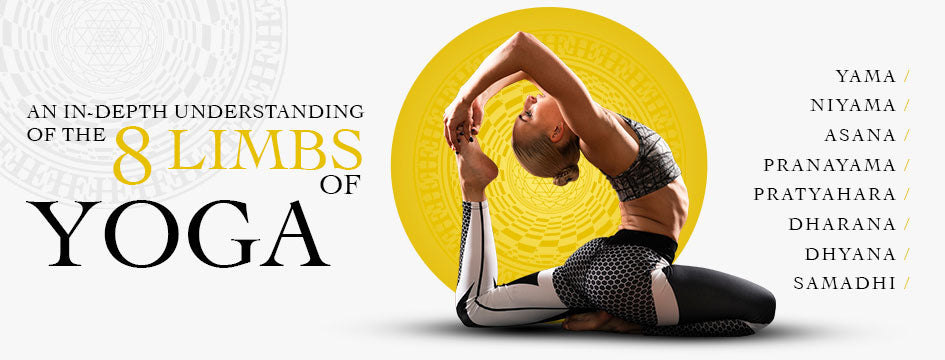
An In-Depth Understanding of the 8 Limbs of Yoga
The 8 limbs of yoga trace their origin to the Yoga Sutras of Patanjali, a guide to reaching self-realization and attaining wisdom through yoga. It is a collection of 196 short verses, written in what is estimated to be 400 C.E., and is often considered the foundation of yoga philosophy.
Today, what we think of yoga is very different from what it actually is. Most people believe it to be a way to lose weight, which is a wrong idea. Yoga is beyond building and toning down muscles; it is a way to understand life from a holistic perspective.
We will look into ashtanga, the eightfold path in Patanjali’s Yoga Sutra. Ashtanga means eight limbs, and it is part of pure yoga. These eight limbs serve as guidelines for living a purposeful life.
What are the 8 Limbs of Yoga?
Yama
It is the first of the 8 limbs of ashtanga yoga. Yama refers to restraints, moral vows, and disciplines. It encompasses an individual’s interaction with the world - their disciplines, practices, and integrity - and how they conduct themselves in life. In other words, Yama teaches the attitudes to follow in the environment around us. There are five Yamas.
- Ahimsa (non-violence)
- Satya (truthfulness)
- Asteya (non-stealing)
- Brahmacharya (non-excess)
- Aparigraha (non-possessiveness)
Niyama

The second of the 8-limb path of yoga, Niyama, deals with self-discipline that also influences the outside world. “Ni” in Niyama means “within” in Sanskrit. A few examples of Niyama are meditation, attending a house of worship, or saying prayers before meals. They are:
- Saucha (cleanliness)
- Santosha (contentment)
- Tapas (heat)
- Svadhyaya (self-study)
- Ishvara Pranidhana (surrendering to the divine)
Asana
Asana means posture. You may be able to relate posture with the thought - the body is a temple. Asana in the 8 limbs of yoga means settling the body down for meditation for better health, free from disease and unease. While the mind is crucial, having a healthy body enables diving deeper and exploring oneself at the spiritual level.
Pranayama
What we know as breath control in English is Pranayama in Sanskrit. Controlling breath gives you power over your respiratory process and helps understand your mind, emotions, and breath. Pranayama promotes rejuvenation, improving your physical self, and extending life.
Pratyahara

Fifth in the 8-limbed path of yoga, Pratyahara means conscious withdrawal of senses. In this state, our senses are devoid of engagement with the external environment. We are aware of everything around yet we are detached from our senses. Pratyahara allows us to look at ourselves objectively, checking our habits and behaviors that negatively affect our lives and promoting betterment.
Five layers surround our consciousness or atman. You can transcend them through yoga and connect with your consciousness. They are:
- Annamaya Kosha: food layer
- Pranamaya Kosha: breath layer
- Manomaya Kosha: mind layer
- Vijnyanmaya Kosha: intellect layer
- Anandamaya Kosha: bliss layer
Dharana
How good is your attention capability? Can you focus on something specific and stay fixed? If not, you are unable to keep yourself away from distractions. Dharana means attention. But if you train the mind, you can focus on concentration, calm your mind, slow down your thoughts, and fix yourself on a single mental object. Once you are one with the moment, you can enter dhyana.
Dhyana
Meditation is the 7th stage of the 8 limbs of the yoga chart. It is the state of uninterrupted concentration, but unlike Dharana, it is the state of being aware without focus. You can feel your mind become still. Dhyana boosts concentration, leaving little to no space for external thoughts, and helps achieve deep rest. It takes a lot of hard work to attain dhyana, and those who do, reach the 8th state of the 8-limb path of yoga - Samadhi.
Samadhi
All the above steps lead to the ultimate state of consciousness - the absorption of the self - Samadhi. In this state, your focus merges with you, and you transcend yourself, forming a connection with the divine. It is the true experience of bliss. Once a person attains the ability to see equally without distractions from the mind, it leads to the end goal - moksha (permanent freedom).
Final Words
According to Patanjali, all human beings aspire for one thing - peace. Yoga can only be experienced through unbreakable devotion. You cannot make it; you cannot break it.




